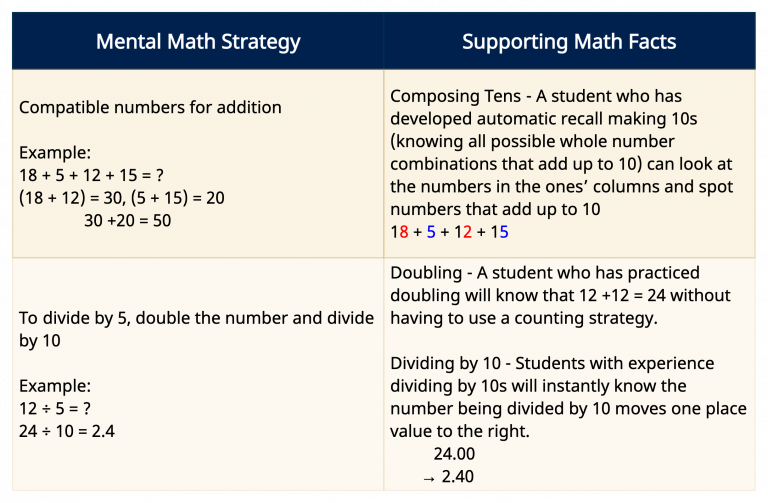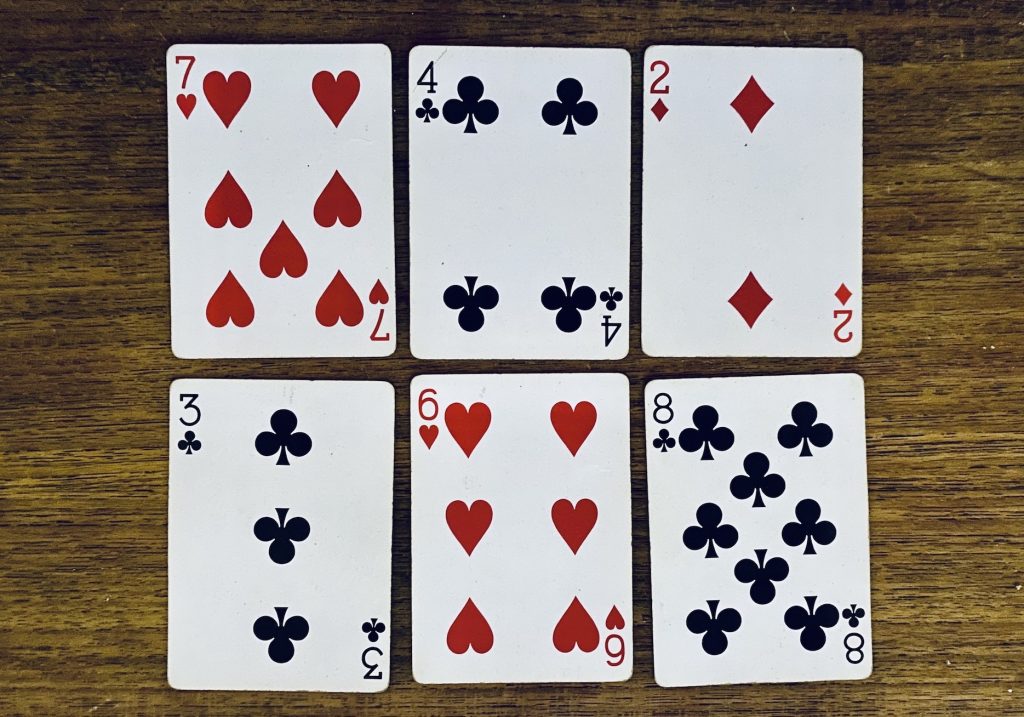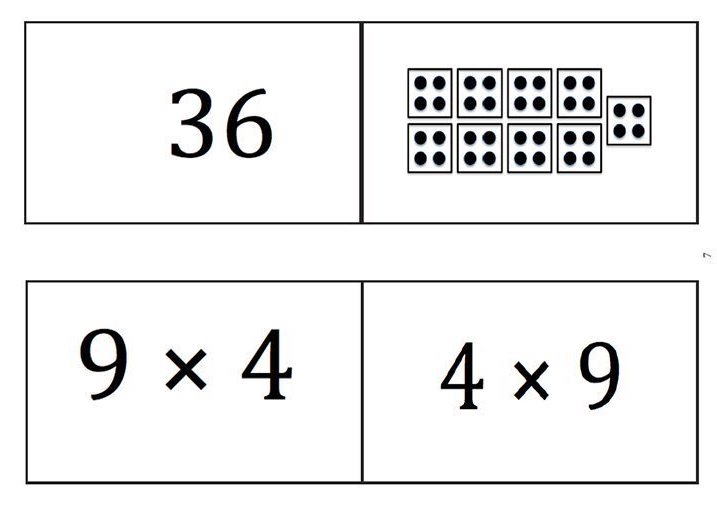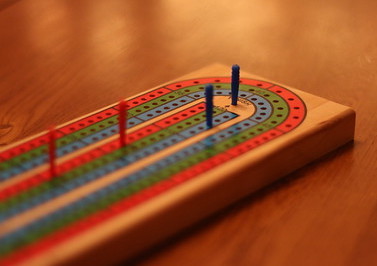Learning basic math facts using playful memorization
When the Ontario government rolled out its new math curriculum in 2020, it was touted as a “back-to-basics” approach. “We’re focusing on fundamental math concepts and skills like learning and recalling math facts including multiplication,” the province’s Education Minister Stephen Lecce said i. It seemed to signal a move from conceptual math learning toward a more traditional approach of teaching through rote memorization and procedure.
While the new curriculum does emphasize the memorization of math facts, it also includes a new mental math component, which focusses on the development of math strategies to build efficiency and flexibility. When approached in a playful context, these two components can work together to support greater math fluency for all students – but particularly for those who struggle.
Landmark research by Gray and Tall considered the way young students solved math problems (e.g., 7+19) ii. The researchers looked at low, average, or high achieving students, as categorized by their teachers, and identified four different strategies being used:
- Counting All – count all the numbers in a problem.
- Counting On – start with one of the numbers and continue counting until they reach the other.
- Known Facts – use facts already committed to memory.
- Derived Facts – use a flexible approach to decompose and compose numbers (e.g., working out 6+20 instead of 7 +19 because 20 is a friendlier number).
Math strategies used by students


Figure 1. Math strategies used by students.
(Gray & Tall, 1994)
The results revealed that among the eight-year-olds, 61% of the high-achievers used “derived facts” (see Figure 1). The low achievers relied on counting — a strategy that appears to simplify the task, but ultimately results in a process that is less efficient and prone to error. Rather than asking struggling students to complete more math questions using the same strategy, students should be introduced to different strategies for approaching the problem.
Memorization supports mental math & struggling students
Many mental math strategies emphasize efficiency and flexibility by finding friendly or compatible numbers, such as those constructed of twos, fives or tens (see Figure 2). Given this, developing automatic recall of certain math facts benefits students’ ability to engage with mental math. For example, the ability to compose and decompose tens, doubling and halving, as well as multiplying and dividing by 10.

Figure 2. Mental math strategies, along with corresponding supporting math facts
(Olsen, 2015)
8 More Mental Math Strategies
Break apart
· 3 x 42 = 3 x 40 +3 x 2 = 120 + 6 = 126
· 215 – 83 = (210 – 80) + (5 – 3) = 130 + 2 = 132
Compensation
· 65 + 38 = 65 + 40 – 2 = 105 – 2 = 103
· 38 x 5 = 40 x 5 – 2 x 5 = 200 – 10 = 190
Use doubling when 2 is a factor
· 2 x 35 = 3 x (2 x 35) = 3 x 70 = 210
To multiply by decimals, drop the decimal point and put it back in later
· 0.5 x 0. 3 = 0.15
Equal additions technique for subtraction
· 74 – 28 = 76 – 30 = 46
To divide by 4, divide by 2 twice
· 68 ÷ 4 – 68 ÷ 2 ÷ 2 = 34 ÷ 2 = 17
To multiply by a unit fraction, divide
· (1/5) x 35 = 35 ÷ 5 = 7
To multiply a fraction times a number, divide and then multiply
· (3/5) x 35 = 35 ÷ 5 x 3 = 7 x 3 = 2
(Olsen, 2015)
Another potential benefit of math fact memorization is that it may support students with working memory challenges or deficits. Although much about working memory is still unknown, it is clear that it plays a vital role in “any form of arithmetic and math that involves processes beyond simple memory retrieval.” iii Though demands on working memory seem to increase when the numbers in a problem get larger and as the number of steps to solve a problem grow, working memory is not implicated in the automatic retrieval of math facts. By helping students build a foundation of automaticity, the demands on their working memory diminish as they engage in mental math.
Playful math fact memorization
Traditionally, helping students build math fact automaticity has been approached through rote memorization techniques such as flashcard drilling and testing. Unfortunately, these methods also frequently result in increased math anxiety iv. This can interfere with students’ ability to process math and negatively impact both their learning and performance v. Thankfully, the goal of building automaticity can be furthered through more playful means. In fact, research suggests games present an ideal method of supporting math fact memorization. Games not only tend to increase engagement and interest, but also support students with gradual memorization, allowing them to come to the answer through counting and reasoning before moving toward memorization vi. This gradual process supports greater conceptual understanding of numbers and math facts, which in turn allows them to apply their understanding more flexibly vii.
Math fact games
Making Tens

A variation of Go Fish, this game sees players collect pairs of cards that add up to 10 (using Ace through Nine in a deck of cards). This helps students build automaticity around composing tens and helps with understanding the communicative property of addition (i.e., both 4 + 6, and 6 + 4 make 10).
A study of struggling first graders found that after three 30-minute sessions working with ten frames and playing Tens Go Fish, 50% of students were able to solve 4 + 6 by recall, an increase from the 0% prior to the sessions vi.
Math Cards

In this game, all math cards are placed face up and students take turns picking up as many as they can find that represent the same answer (shown through any representation).
A full set of printable cards, as well as a number of other games recommended by Boaler and Williams (2015), can be found here.
Cribbage

For junior and intermediate students, Cribbage presents similar opportunities to Making Tens – Go Fish in a more complex structure. Players receive two points each time they use two or more cards to make 15 (composing 15s). They also receive points for making pairs, runs, or flushes. The game supports counting by twos and composing 15s. It also develops an understanding of strategy and probability.
Instructions for play: https://bicyclecards.com/how-to-play/cribbage/
Play online: Cribbage using playingcards.io
Doubling

Using Ace to 10 cards from a deck of cards, players pull a card, double the value and colour in a square above the correct column. The game is done when one column is completely filled. Adapt the game by using a die and adjusting the board so that it goes up to 12. Or, have players double the sum of two cards by adjusting the board so that it goes up to 40. Alternatively, use all cards in the deck, assigning all face cards a value of 10. Have students guess which column will fill up first. Compare notes at the end and have students consider why 20 may come up more frequently.
Authors
Charlotte Henderson
Teacher; Graduate of MA-CSE Teacher Education Program (OISE/U of T)
Claire Ogden
Teacher; Graduate of MA-CSE Teacher Education Program (OISE/U of T)
References
- Jones, A. (June 23, 2020). Ontario’s new ‘back-to-basics’ math curriculum includes budgeting, coding. HuffPost Canada. https://www.huffingtonpost.ca/entry/ontario-new-math-curriculum_ca_5ef25375c5b6045b10193b75#:~:text=The%20new%20curriculum%20is%20part,is%20back%20for%20our%20kids.%E2%80%9D
- Gray, E. M., & Tall, D. O. (1994). Duality, ambiguity and flexibility: A ‘proceptual’ view of simple arithmetic. Journal for Research in Mathematics Education, (25)2, 116-40.
- Ashcraft, M. H., & Krause, J. A. (2007). Working memory, math performance and math anxiety. Psychonomic Bulletin & Review, 14(2), 243-248.
- Geist, E. (2010). The anti-anxiety curriculum: Combatting math anxiety in the classroom. Journal of Instructional Psychology, 37(1), 24-31.
- Wang, Z., Lukowski, S., Hart, S. A., Lyons, I. M., Thompson, L. A., Kovas, Y., Mazzocco, M. M., Plomin, R., Petrill, S. A. (2015). Is mathematical anxiety always bad for math learning? The role of math motivation. Psychological Science, 26(12), 1863-1876.
- Bay-Williams, J.M., & Kling, G. (2014). Enriching addition and subtraction fact mastery through games. Teaching Children Mathematics, 21(4), 238-247.
- Boaler, J., & Williams, C. (2015). Fluency without fear: Research evidence on the best ways to learn math facts. Retrieved November 14, 2020 from https://www.youcubed.org/evidence/fluency-without-fear/
- Olsen, J. (2015) Five keys for teaching mental math. The Mathematics Teacher, 108(7), 543-548.
